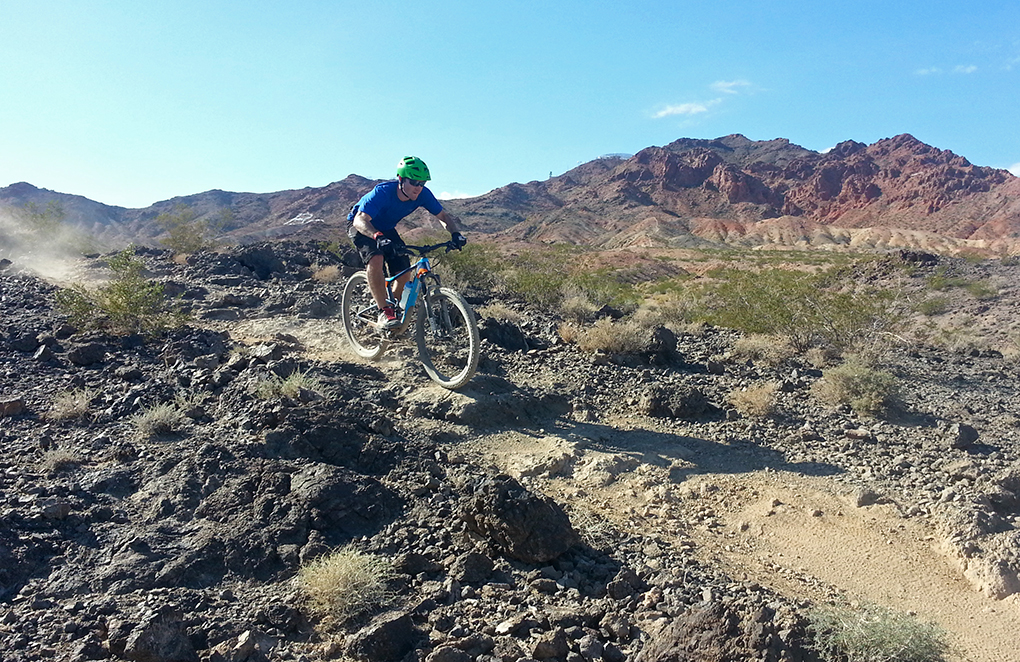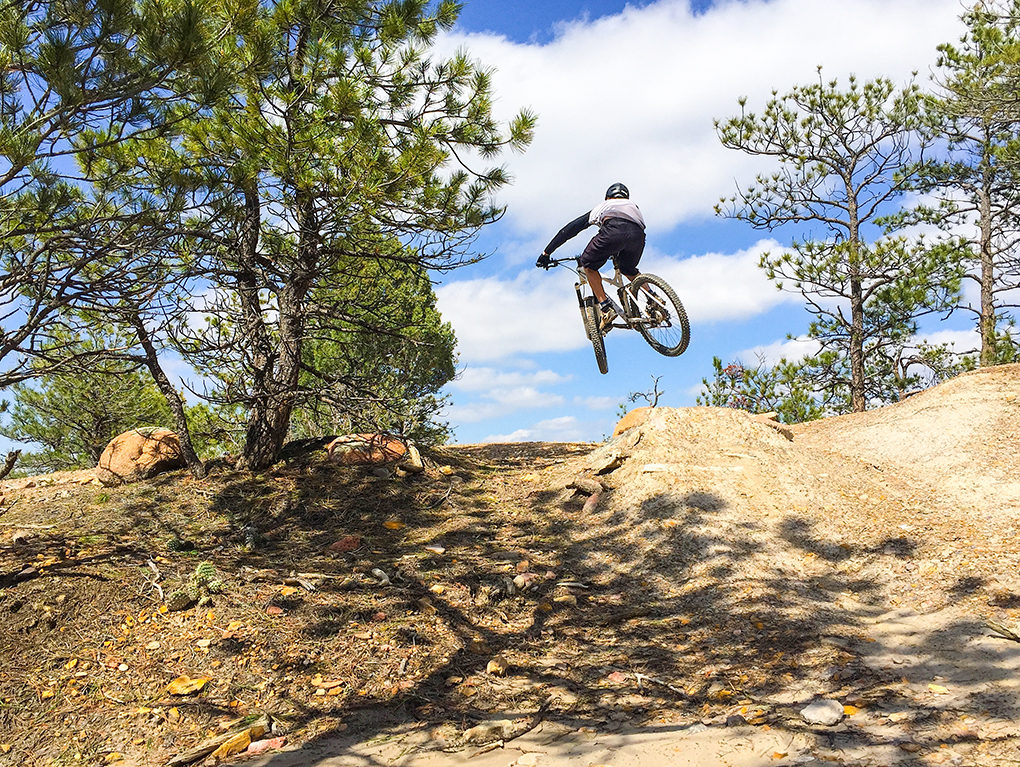Q: While the benefits of running a tubeless system are hopefully obvious by now, many people are put off by the often frustrating and potentially messy process of setup. While a solid rim and tire combination will make setup infinitely easier, what are some of your tips and tricks to mounting up uncooperative tires?
Tom: When possible, I do it all by hand. Getting the bead into the track in the middle of the rim (that dip shown in all the cross section images) makes it easier because it has a smaller circumference than the rest of the rim and so it decreases tension on the tire bead. I also use lots of soap and water to help get a good seal and indicate where it is leaking.
Noah: I’m pretty lazy, so I’ll resort to tire levers pretty quickly. For particularly stubborn tires, I have a couple of big ass metal tire levers intended for mounting dirt bike tires. They scratch my rims, but I don’t really care.
Tasha: Once the tire is pumped up and appears to be sealed, I close the valve and bounce the wheel on the ground to help the tire bead seat nicely.
Xan: I’m a big fan of using soap and water. If a tire is being stubborn, I usually try to help it seal by shaking it back and forth to slosh the sealant around.
Marshal: Once the tire is on, I will work the bead around and pull it into the bead channels as best I can. From there, I hit the tire with pressure slowly, 5psi at a time, and visually inspect the bead to see where it is and where it isn’t fully seating. You can “roll” the tire laterally to pop the bead on if it’s not snapping on. I also like to install a tire, then immediately go ride to spread the sealant.
Q: Do you use a compressor? And do you get better results from some expensive compressor, or is some used thing off of Craigslist just as good?
Tom: Nowadays you can usually get away with a floor pump on most tires.
If that doesn’t work, you can go to a gas station with a coin pay air compressor. When using one of these, take your valve core out—the smaller diameter threaded part has two flats on that. Use a crescent wrench to unscrew it. Taking it out lets a TON more air in by making the hole bigger, and therefore makes it easier to get the bead to seat (hook into the rim).

It is somewhat interesting to try to thread that back in when there is air in the tire, but it isn’t so much harder than closing the valve on a pool floaty. Once you’ve threaded it back in by hand, tighten it a bit with the wrench (doesn’t need to be much though). Tightening it a bit prevents it from wiggling loose while you ride, or getting unscrewed when you use a pump to add more air.
Because I love tools, I do have a compressor at home. It was less than $100, and it works fine. There aren’t any special characteristics you need to look for if you are shopping for one, but compressors do wear out, so getting an old compressor off Craigslist isn’t the best idea. If you are interested in compressors, google searches will yield a wealth of info and solid options.
Noah: Yup. On better tires (most Maxxis options, WTB, Schwalbe), I’ve found I don’t need it. On the best tires (usually one of the aforementioned companies, but in a DH casing), I think I could actually get them to seat using a mini pump.
These days, as both rims and tires are becoming more friendly towards tubeless setups, a normal floor pump seems to get the job done most of the time. But occasionally I’ll still use the compressor for stubborn tires.
Tahsa: Sometimes. I use an air compressor for tires that won’t seat nicely and will usually remove the valve core for these jobs.
Xan: I don’t own a compressor, so usually not. Luckily, all of my favorite tires are easy to seat with a floor pump.
Marshal: I have a super cheap $50 compressor at home, it’s pretty handy, but not entirely necessary.
Q: While tubeless tires are much less prone to flatting, failures still can and do occur. How do you do on-trail repairs?
Tom: I throw a tube in and carry on.
Noah: I carry a tube on any ride that’s long enough that I can’t just walk out.
Tahsa: I always have an extra tube that I can throw in if the tubeless seal is broken. If I just have a tiny slash in the tire from a rock I will pump the tire to around 30 psi and finish the ride as quickly as possible.
Xan: I carry a spare tube with me, but treat it as a last resort. Most of the tears I get while riding in Colorado are small punctures rather than full on gashes, so I’ll try to get it to seal. I’ve had pretty good luck with getting these types of tears to seal with a combination of aggressively bouncing the wheel on the ground and sloshing the sealant around.
Marshal: Tube it and deal with it at home.
Q: How do your tubeless tires typically fail?
Tom: Tears in the sidewall from hitting sharp rocks or slowly wearing out the casing until it is threadbare.
Noah: I’ve blown quite a few tires off the rim, and once that happens, it seems like the bead stretches out a bit and they don’t really work well for tubeless after that. Other than that, it’s just the occasional sidewall tear or gash in the tread.
Tasha: Tearing a sidewall or the tread on rocks. Due to better interfaces between rims and tires, I haven’t burped air in a while.
Xan: I usually tear tires on rocky flat landings. It’s almost always a tear in the tread rather than in the sidewall. Burping is also an issue for me, but I’ve never completely blown a tire off.

Marshal: I cut the rear tire in the negative space between knobs pretty regularly (once every 40-50 rides), and cut the sidewall much less frequently (once every ~100 rides). Going to tires with less negative space in the rear tread has really eliminated a lot of flats for me, and running at least an 800g tire has dramatically reduced torn sidewalls.
Q: Any other Tips or Tricks?
Noah: Use Gorilla Tape to seal the rim. It’s much easier to install than that plastic-y Stan’s tape that likes to come un-stuck. It’s cheaper too.
If you’re really having a hard time getting a bead to seat and a tire to take air, wrap a strap around the circumference of the tire (so the strap is compressing the whole tire into the rim). This will cut down on the volume in there and help the pressure build up more quickly, thus seating the bead. Once you build enough pressure to start to seat the bead, release the strap and proceed as normal. If that fails, set up the tire with a tube in it and leave it inflated for a day. Then pull the tube out (leaving one of the beads seated), pour in your sealant, and take another stab at it.
Along the same lines, some tires that come folded in their packaging will set up more easily if you either set them up with a tube first or unfold them, put them in their “normal” shape, and let them sit for a day or so.
Xan: Stubborn tires may stay better sealed if you leave them lying flat on each side for 10 minutes or so after mounting.
Marshal: Carry spares, bring a tube/CO2, run your tires properly inflated (check every ride), don’t ride like a hack, and you will very rarely have a problem.

Great tips. When I set up a new tire, assuming I won’t go riding right away, I like to leave it pumped up to 50-60psi over night. I also spin the tire around sideways (like a top) on both sides to coat the inside with Stan’s. I just think that coating the inside of the tire, plus the high psi, helps push sealant into the pores of the tires.
Great article. My tips/additions, after 10 years of tubeless experience:
1. After setting up tubeless, slosh tire laterally 10 times, rotate 1/8 turn, repeat for two full tire rotations.
2. Bontrager may not make the best wheels in the business, but their TLR tubeless system and TLR tires are great. I’ve also had perfect luck with Roval Carbon (hooked version) and Derby AM rims.
3. Schwalbe Snakeskin tires seal up easily. The regular versions of the Racing Ralph and Rocket Ron can be inconsistent in their success.
4. When installing a new layer of Gorilla Tape on a rim, inflate an old tire and tube onto it and leave it sit for 10 minutes to really “press” the tape firmly into place.
5. Sears has great sales a couple of times a year. Ask for a compressor for a gift. It makes tubeless life so much more enjoyable!
6. It’s hard to beat Stans sealant. Not cheap, but if you really use a lot, sweet talk your LBS guys into filling a bulk container for you (I’m pretty sure that my LBS still gets it in 5-gallon pails).
7. When you start seeing sealant seeping through the sidewall, it’s about time to quit spinning the karmic roulette wheel of blown tire death, and go shopping for a new tire!
Thanks Mike and Thanks Tom – Great tips!
Instead of soapy water, I moisten the outside of the tire bead with a little Stan’s sealant before inflating. That way, I get the quicker seating that soap and water provides, and the Stan’s helps fill any small gaps between the (inflated and seated) bead and rim.
Great tips, thanks!
Like Maciej above, I wet the exterior of the bead with Stans prior to inflation, it seems to help immediate sealing and lubricates the bead.
2 Liter Soda bottle tire inflator instead of a compressor! (can take it on road trips as well)
http://www.vitalmtb.com/forums/The-Hub,2/Joe-Barnes-DIY-Coke-Bottle-Tubeless-Compressor-Hack,8450
All tape fails after a few years, usually due to sealant getting under the tape and ruining the adhesive. So retape stubborn deflating tires, or every few years.
Scotch version of tubeless tape = $6 for 60 yards, similar or same as Stans tape.
http://www.amazon.com/gp/product/B00C0Z1Z5C
A sidewall cut is the death of the tire for tubeless.
Water helps to reseat a stubborn bead when fitting a tube in the field.
Lots of cut tires = expensive habit!!!
P
This article encourages me to stay with tubes more than switch to tubeless.
How much sealant would you guys recommend putting in? Say in a 2.4 in tire. Is it worth it to have extra sealant sloshing around? Or will that just quickly dry up?
In a 27.5 x 2.4 tire I pour in Stan’s until there is a small sloshing pool. That is usually just enough to distribute all around a tire. It is approximately 2 full scoops of sealant. The sealant does dry up, but not too quickly. Having some excess in your tire will allow it to seal small punctures and let you finish a ride without throwing a tube in.